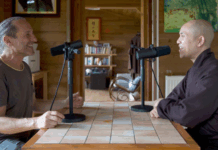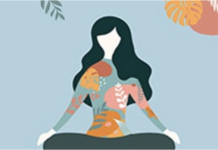Mindfulness of Emotions

Context
Before I share how mindfulness can help us manage painful emotions, I want to provide some context by saying three important things.
First, it’s okay to be human. We all experience painful emotions from time to time. At least I do. In today’s busy world, so many of us lack opportunities for real, emotionally vulnerable conversations and are under the impression that we’re the only person who feels what we feel. We are like a frog in its well who has never visited the wells of other frogs, and we take our emotional life way too personally. Everyone has some suffering. This is bad news, of course, but it is also good news because it means that there is nothing fundamentally wrong with you and that you are not alone.
Second, please take a holistic approach to your mental health. Wellness is multifactorial, and you don’t want to rely only on your mindfulness practice to prevent and manage difficult emotions. Meaningful human connections, getting enough sleep at night, physical activity, time in nature, wise media consumption, and other practices in the Daily Wellness Empowerment Program all contribute to a much more pleasant emotional landscape, so please make full use of all of them.
And third is, please practice mindfulness as a way of life, not as a quick fix. Practice sitting meditation, breathing breaks, mindful walking, and try to live each moment as mindfully as you can, so that, when an emotion comes up, you will have more mindfulness energy to embrace it. Mindfulness is not a quick-fix tool to pull out of your pocket when, as the poets say, shit hits the fan. Mindfulness is a way of life.
The River Metaphor
With these three things being said, when an emotion comes up, you want to come back to your breath and look at your emotion from a spacious and kind awareness.
Imagine you are drowning in the middle of a river. You’re in the dark. You can’t breathe. So you push yourself to the surface, you catch your breath, and you swim to the bank of the river. From the bank, you look at the river. The river is still turbulent and murky, but you’ve made it to safety. And gradually the river becomes calmer and clearer.
This was a metaphor. The river represents your emotion. The breath is your mindfulness of breathing. And the bank is your spacious and kind awareness.
When we experience a strong emotion, we get entangled in our thoughts — we get sucked into them, and we don’t have much space for anything else. Steven C. Hayes, a professor of clinical psychology and the founder of Acceptance and Commitment Therapy, calls this “cognitive fusion”. When we are “fused” with our thoughts, psychologically, we drown.
To “defuse”, to push yourself back to reality, I encourage you to first get in touch with your breath. Close your mouth, and give all your attention to the sensations of your breath naturally coming in and naturally going out. Be present to the breath, and patient with the breath. Stay with the sensations of your natural breath, breath after breath after breath.
Once your attention is stably established on your breath, notice other sensations going on in your body: is your forehead strained? Are your eyes watering? Do you have a lump in your throat? Are your shoulders tense? Are your fists clenched? Is your heart racing? Is your stomach upset? Is your belly tight? Are your legs shaking? Are you feeling particularly hot or cold anywhere in your body? Observe your physical sensations as they are, and see how they are in a state of flux, changing. Allow all of your sensations to flow, and, if they want to, to relax.
Then, notice the thoughts that pass through your mind. Whatever their content may be, see each thought as just that — a thought. A thought comes, stays for a while, and goes. Another thought comes, stays for a while, and goes. Observe how thoughts want to pull your attention in, and instead of being drawn into their content, simply be aware of the thoughts for what they are: thoughts. Instead of trying to control the thoughts, let them come and go naturally. Instead of identifying with the thoughts, be the spacious, light, and kind awareness in which everything comes and goes.
This spacious and kind awareness is your safe bank. Turbulent sensations and murky thoughts are still flowing, but you are no longer drowning in them. In this spacious and kind awareness, you are in touch with the fullness of the present moment, and you have more freedom to decide what you would like to do from there. Practitioners of Acceptance and Commitment Therapy call this “psychological flexibility”. The emotion may still be there, but you are no longer drowning in it. You are more open, aware, and meaningfully engaged with reality.
Another Way to Relate to Emotions
Without mindfulness, we tend to either
- totally identify with the emotion, act on it automatically, and feel regret, or,
- discriminate against the emotion, suppress it, and feel stressed.
We may want to reflect,
- How many times have I been carried away by my emotion, and how well has it worked for me?
- How many times have I suppressed my emotion, and how did that make me feel?
- Is there a better way I can experiment with?
Yes, there is. The mindful way encourages us to relate to our emotions with more inner space, kindness, and awareness. We know the emotion is there, and we acknowledge it for what it is, without the urge to act on it, change it, or get rid of it.
Being aware of how we’re feeling when we’re feeling it is the foundation of emotional intelligence and a key condition for happiness. In psychology, this is known as “affect labeling”. When we’re sad, we recognize that sadness is there. When we’re angry, we recognize that anger is there. When we’re desirous, anxious, irritated, frustrated, or confused, we know that desire, anxiety, irritation, frustration, or confusion is there. We want to be able to mentally call each of our emotions by its name. Studies show that simply naming our painful emotion can slightly reduce its intensity and duration and help us make better decisions.
Self-Awareness
Without self-awareness, we are like a drunk person who thinks, “I’m not drunk. I can drive!” We drive through life, we drive through our relationships, under the influence of craving, anger, and confusion… and we get into a lot of accidents. So when we experience a strong emotion, the strict minimum is to acknowledge it, because when we know how we feel, we can make more helpful choices. “Right now, I’m really angry: maybe it’s not the right time to go speak with this person.” “Right now, I’m really depressed: maybe I should stop looking at pictures of my ex on social media and do something more constructive.” “Right now, I’m really exhausted: maybe I need a power nap before I resume my work.” When we know that we are, emotionally speaking, under the influence, we can minimize the damage of our emotion and redirect ourselves toward more helpful behavior.
As you practice mindfulness of your emotions, please be on the lookout for any subtle tendency to suppress your emotion. As you follow your breath and observe your sensations and thoughts, it’s possible that a part of you is thinking, “Hey, I’m doing mindfulness right here, I’m accepting you from a space of loving attention, and when I accept you from that space of loving attention, remember, emotion, it’s the sign that you should get ouuuuuuutta heeere!” Haha. That is not going to work very well. Please remember, this is loving attention, not suppression. Our practice is not to trim our heart into a banzai. Our practice is to offer each of our emotions the sunshine of our awareness, the water of our kindness, and to allow our emotional landscape to flourish beautifully.
(Silence, closing my eyes, smiling.)
Sorry, I was mindfully attending to the pride I felt for coming up with such a poetic metaphor. Anyways!
The key takeaway is that when you’re experiencing a strong emotion:
- find your breath,
- observe your physical sensations,
- notice your thoughts, and,
- be the light, spacious, and kind awareness.
From there, you can make more informed choices that are more in line with your values.
In my experience and in the experience of other practitioners, although mindfulness brings more presence and kindness to our emotional landscape, we still feel and go through all emotions. If anything, mindfulness makes us more sensitive, more human. When we practice sitting meditation, breathing breaks, walking meditation, mindful eating, or mindfulness in other daily activities, we connect with everything happening within us, pleasant and unpleasant, comfortable and uncomfortable. We redefine our relationship to ourselves, from avoidance to presence, from discrimination to kindness, and from contraction to spaciousness. Mindfulness helps us tap into our own potential for self-regulation, mental clarity, and empathy. Mindfulness helps us recognize the cold, dark, forsaken parts of our souls, and slowly fill them with warmth, light, and presence. With mindfulness, we not only feel better, we also become better at feeling. Mindfulness helps us grow into a more whole, more complete human being. Mindfulness helps us to discriminate less against ourselves, to know ourselves more deeply, and to cultivate a gentle form of self-honesty. Mindfulness helps us connect truthfully with whatever it is we’re feeling, because, as the Buddha said, “You have to keep it real.” Unless he never said that and I just confused Buddhist wisdom with hip-hop wisdom. But still. You gotta keep it real. If you need to cry, cry mindfully. If you need to go for a run, go for a run mindfully. If you need to confide in someone, confide in someone mindfully.
Please, do not expect your mindfulness practice to make you perfectly peaceful and clear-minded all the time. Expect your mindfulness practice to make you more peaceful and more clear-minded than without mindfulness. Mindfulness is not about pretending or imposing some idea onto reality. Mindfulness is about tuning into the reality of your breath, the reality of your feelings, and bringing a little more presence, a little more kindness, a little more clarity into this beautiful mess called life.
Shame
I have been a monk for fifteen years but I still make mistakes regularly. Although my mindfulness practice has allowed me to become an overall much calmer, kinder, and happier person, from time to time I still think, say, or do things that I regret. I get carried away, and then I feel shame. Shame is an important emotion that I’d like to share some thoughts about.
Our world needs shame. As a thought experiment, what would a world without shame look like?
… Right?! So our world needs shame. Shame is a preventive and curative medicine. But just like any medicine, shame needs to be handled wisely. In the right case and in the right dosage, shame prevents us from hurting ourselves and others, and shame helps us mend our mistakes and become a better person. But in the wrong case or in the wrong dosage, shame becomes toxic: it destroys our self-esteem and robs us of the opportunity to live fully and meaningfully the present moment.
Instead of asking ourselves “How can I stop feeling shame?” it is better to ask ourselves,
- Is shame the appropriate response for this situation?
- Am I using the right dose of shame? and,
- What concrete behavior would be more in line with my values?
We don’t want to deny our mistakes. We want to see every mistake, big or small, as an opportunity for growth. When we calmly look back at our mistake, we can identify the various conditions that brought about our unskillful thought, word, or action. The more we see these conditions, the more we naturally create a space of understanding and forgiveness for ourselves. We recognize that we are human, subject to inner and outer conditions, and that our willpower has its limits. And, at the same time, the more we see these conditions, the more informed and motivated we are to do better in the future. We want to look at our mistake the way a programmer looks at a bug in her program, and become the engineer of our own and other people’s happiness.
This way, shame becomes a supportive companion, the true medicine it is meant to be.
Resistance
Most of our suffering comes from our constant struggle to escape unpleasant physical sensations and pursue pleasant physical sensations. At any given time, within our body there is an ocean of sensations — some pleasant, others unpleasant, all rising and falling at unfathomable speed. And in our consciousness, there are the tendencies to resist and reject unpleasant sensations while craving and pursuing pleasant sensations. So we are constantly rejecting one part of our experience while craving for another, and in doing so we are dividing our mind. And is this division itself pleasant or unpleasant?
Do you enjoy being divided?
A divided mind is a suffering mind, and an undivided mind is a peaceful, open, light, and happy mind.
There are many ways for us to release some of this division and enjoy a more undivided mental space. I don’t have time to go into detail here, but one simple way you might like to experiment with is to ask yourself, “How is this emotion trying to help me?”
This simple question can really shift your attitude, from seeing your painful emotion as an enemy, to seeing it as a friend who comes to inform and protect you. Anger, for example, tries to help you restore healthy boundaries, so that you can build happy relationships. Desire tries to help you survive, as an individual and as a species. Fear does its best to keep you safe and sound. Sadness allows your pain to flow and water your seeds of empathy. Boredom encourages you to experience life more fully and meaningfully. And frustration speaks to you about your unmet needs.
The goal of asking, “How is this emotion trying to help me?” is for you to release some of the resistance to your painful emotion, to let go of your mental division, to allow unpleasant physical sensations to flow freely, and to hear your emotion’s message. You know you’re practicing this contemplation correctly when you experience a relief: your body becomes a little more relaxed, and your mind becomes a little more open, light, and whole.
Seeing your emotions as trying to help you doesn’t mean that all of your emotions are “right” and that you should blindly follow them. It simply means that they’re here for a reason and that they’re doing their best. A good analogy would be to think of emotions as advisors, and mindfulness as the king. It is important for the king to listen to his advisors, and it is also important for the king to make the decisions. If the king doesn’t listen to his advisors, he will make uninformed decisions, but if a single advisor takes control of the kingdom, it will be a mess. In the same way, if you don’t mindfully listen to all of your emotions, you won’t be able to make emotionally intelligent decisions, but if you allow any one of your emotions to run your life, it will be a mess. What you want is to listen to all the parts of you, and make mindful, informed, and wise choices.
Article republished with permission from mentalhealthrevolution.org

















